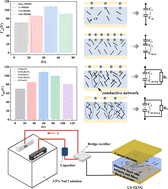Contact-separation mode triboelectric nanogenerators (CS-TENG) have received widespread attention in self-powered cathodic corrosion protection, but their relatively low output limits the application. This paper introduced both groove textures and carbon-fillers into CS-TENG and investigated the influences and mechanism of textures and filler parameters on the output of CS-TENG. Through the external connection to the protected metal, the CS-TENG with optimal textures and fillers established the power supply of the self-powered cathodic protection. It is shown that for CS-TENG with groove textures, a texture size of 10 μm–10 μm exhibits the maximum lateral deformation, which generates the largest contact area and lateral deformation, and thus outputs the highest voltage. Among the three selected carbon-fillers (carbon fibers, hard carbon particles, graphene oxide), carbon fibers with 0.5 wt% mass fraction provide the highest charge storage capacity and thus the largest electrical output. Compared to the CS-TENG without textures and fillers, the open-circuit voltage of CS-TENG with optimal textures and fillers increased by 165.08%. Cathode anti-corrosion experiments and EIS (electrochemical impedance spectroscopy) tests indicate that CS-TENG with optimal textures and fillers significantly reduce the electron transfer rate on the metal surface, exhibiting excellent anti-corrosion performance.
